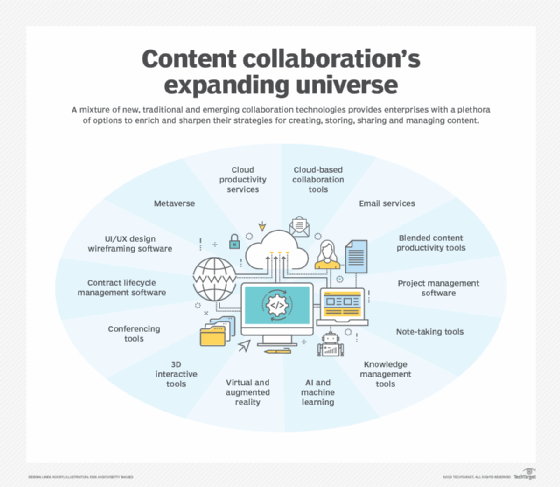10 content collaboration platforms for enterprises in 2025
Organizations must stay organized to boost efficiency. Content collaboration platforms can help, but business leaders must choose carefully to find one that best fits their needs.
Content collaboration platforms enable organizations and their employees to manage files, streamline processes and maintain a smooth workflow from conception to delivery.
Over the last few years, content collaboration software has gone from a nice-to-have to an absolute must-have in technology stacks. Driven by an abrupt shift to remote work in 2020, wider acceptance of hybrid and remote work environments, and the addition of social software as a feature, the market is expected to experience rapid growth.
What is content collaboration software?
Content collaboration software helps teams upload and organize content, facilitate file sharing and perform simultaneous workflows. It's typically cloud-based and supports project management, workflows, information management, analytics and version control.
Features to look for in content collaboration software
Most content collaboration platforms share similar features, such as the ability to upload and share documents, annotate documents, chat and leave comments. Modern tools also have expanded to include mobile apps for iOS and Android devices and APIs to integrate with third-party extensions and software. The critical features organizations should consider when choosing content collaboration software include the following:
- Real-time editing and commenting. Regardless of physical location, multiple individuals can work on a document simultaneously, which streamlines workflows and improves efficiency for deliverables.
- Version control. If someone accidentally deletes important information in a document, version control lets users restore previous versions. Some content collaboration platforms also include the ability to track who made changes so users can easily discuss any changes.
- Security. While some industries, such as healthcare and finance, are tightly bound by regulators to protect data, every organization must consider security when choosing a content collaboration platform. The security features can include encryption, multifactor authentication and role-based access to minimize damage if a user's credentials are compromised.
- Integration with other tools. Usually accomplished with APIs, integration can enable organizations to connect their systems to help improve processes.

Top enterprise content collaboration platforms
While there are many content collaboration platforms to choose, the choice depends on the organization's needs. For example, a company might be more interested in a platform that has strong project management or security features to protect highly regulated and sensitive data.
Explore 10 enterprise content collaboration platforms, in alphabetical order, that have risen to the forefront of the industry based on professional and user reviews.
1. Amazon WorkDocs
Amazon WorkDocs is a content collaboration platform that provides version control, comments, notifications and the ability to request feedback from other collaborators. It integrates with Microsoft 365 for editing and uses Hancom Office Online to enable real-time file creation and editing.
While the platform offers several key features, many reviews on Gartner and G2 caution that when using the desktop app, the cloud version might crash, creating conflicting versions of files.
In most places, pricing for Amazon WorkDocs costs $5 per user monthly. However, it depends on the number of active users and the region.
2. Bitrix24
Bitrix24 combines tools like customer relationship management, file storage, kanban boards, workflow automation and document sharing into its content collaboration platform. Bitrix24 Drive -- its file storage tool -- supports third-party integrations with other tools such as Box, Dropbox and Google Drive, allowing real-time editing and collaboration.
The most given strength of Bitrix24 is its project management tools, and using it has made it easier for some to communicate internally. However, others caution that the user experience is difficult, particularly because some tools are hard to find.
Bitrix24 offers five pricing plans. When billed annually, the Basic plan is $43 monthly for five users, whereas the Standard plan is $87 monthly for 50 users. The Professional plan is $175 monthly for 100 users, and the Enterprise plan costs $325 monthly for 250 users. Customers can also choose a free plan, which offers a more limited tool set.
3. BoostHQ
Promoted as a knowledge sharing platform, BoostHQ by SkyPrep has the hallmark tools and features of a content collaboration platform. Its tool set includes file and content sharing, the ability to organize content based on customized groups, categories and tags and an online learning community that lets users start discussions and upvote comments on a piece of uploaded content. Users call out its integration with Google Docs and its Chrome browser extension that lets users share web content with teammates.
Users on Capterra acknowledge the platform's shortcomings in accessing content offline and that the Q&A feature isn't mobile-friendly.
BoostHQ offers a free 14-day trial. Pricing information for paid plans isn't readily available on the vendor's website.
4. Box
Box is a cloud platform that enables file sharing and collaboration through user-created workflows and project management tools, including tagging other users and annotating documents. Box has integrations with more than 1,500 apps and offers a developer platform for custom integration.
Through a partnership with Adobe, Box provides users with PDF tools that include creating and adding electronic signatures to PDFs, which enables users to complete more tasks within Box rather than switch between browsers. However, Box doesn't include end-to-end encryption, and the time to upload files can be slow.
Box offers four pricing plans for business users: Business, Business Plus, Enterprise and Enterprise Plus. When billed annually, Business is $15 per user monthly, Business Plus is $25, Enterprise is $35 and Enterprise Plus is $50.
5. ShareFile
ShareFile -- formerly part of Citrix, now part of Progress -- lets users create workflows, coedit documents, collect real-time feedback and gather e-signatures. The platform can restrict documents to view-only and offers click trails so users can see who was in the document at what time.
According to users, it's relatively easy to integrate with Microsoft products and collaborate outside the organization. But ShareFile doesn't integrate well with non-Microsoft products, and some users indicate that support can be slow to respond.
ShareFile offers four pricing tiers: Advanced, Premium, Industry Advantage and Virtual Data Room. When billed annually, pricing for the Advanced tier is $16 per user monthly, the Premium tier is $25, Industry Advantage is $41.67 and Virtual Data Room is $67.50.
6. Dropbox
While best known for its file storage capabilities, Dropbox is also a content collaboration platform. It supports integration with tools such as Zoom and Slack, includes project management functions such as assigning tasks and creating workflows, and allows for annotations on documents -- whether they are PDF, Microsoft 365 or image files.
Regular Dropbox users cite its strong security and search features, while some caution that it also has long sync and update times and that customizing the workspace is difficult.
Dropbox offers two pricing tiers for organizations: Plus, Essentials, Business and Business Plus. When billed annually, Plus is $9.99 per month, Essentials is $16.58, Business is $15 per user monthly and Business Plus is $24.
7. Egress Secure File Sharing and Collaboration
Egress Secure File Sharing and Collaboration lets users set up secure workspaces and create secure zones to organize content. It offers real-time file editing and annotation and enables system administrators to set retention policies. Egress also tracks all admin activity and creates audit logs.
Customer testimonials from Gartner and Capterra said Egress offers a seamless installation, is easy to use and users are impressed with the level of security. Other users caution that the interface can feel outdated, and the platform is a little slow on startup.
Pricing information is not readily available on the vendor's website.
8. Google Drive
Google Drive is a cloud-based component of Google Workspace that lets users collaborate on projects using tools from Google's app suite -- Docs, Sheets and Slides -- and other file types like Word documents, PDF files, CAD files or images. Users can leave comments, tag other users and search using Google's technology to find files.
Individual users have My Drive, which lets the owner choose with whom to share files. Alternatively, a project manager or designated employee manages the shared drive and determines the content recipients and their access levels.
Users from Capterra said Google Drive integrates well with other apps, is easy to use for real-time collaboration and provides good customization options. Still, some have reported that Google Drive needs better encryption, and that version control can be tricky.
Google Workspace offers four pricing tiers: Business Starter, Business Standard, Business Plus and Enterprise. When billed annually, Business Starter is $6 per user monthly, Business Standard is $12 and Business Plus is $18. Pricing information for the Enterprise tier is not readily available on the vendor's website.
9. Microsoft 365 and OneDrive
Microsoft 365 is a suite of productivity apps that includes OneDrive, a Microsoft cloud storage service with file sharing capabilities. Through Microsoft 365, users can share and collaborate on files inside and outside their organizations, while OneDrive offers access control, real-time data synchronization and version control.
Unsurprisingly, OneDrive integrates well with other Microsoft 365 products, allowing users to edit documents in real time and receive automatic notifications about changes even if they have logged out of the portal. Google Android and Apple iOS users can also access content via mobile apps, helping users continue working on documents, regardless of where they are.
Users can generate links to content they send through email or the OneDrive menu. These links are convenient but can also be a security liability. To combat these concerns, Microsoft lets owners expire links after a specified amount of time and retract links to avoid long-term access.
Microsoft 365 with OneDrive offers three pricing plans for businesses: OneDrive for Business, Microsoft 365 Business Basic and Microsoft 365 Business Standard. When billed annually, OneDrive for Business is $5 per user monthly, Business Basic is $6 and Standard is $12.50.
10. Zoho WorkDrive
Zoho WorkDrive is another content collaboration platform that includes a suite of productivity apps -- Writer, Sheet and Show. The platform supports offline work, with any changes syncing to the team folders as soon as there is internet access. Users can set permissions by role and control who can view or download files.
User reviews often cite Zoho WorkDrive as a good alternative to Google Drive and praise its integration with other Zoho products. However, some users mention that file uploads can take a long time and that customer support isn't as responsive as they'd like.
Zoho WorkDrive offers three pricing tiers: Starter, Team and Business. When billed annually, Starter is $2.50 per user monthly, Team is $4.50 and Business is $9.
Editor's note: This list was compiled based on a combination of market reports and vendor rankings from Gartner Peer Insights, Capterra and G2, plus additional research by TechTarget editors.
Christine Campbell is a freelance writer specializing in business and B2B technology.







